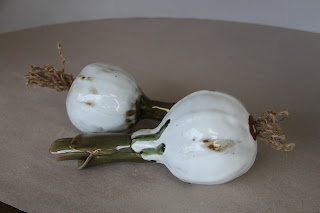This winter I brought my hand-builing clay class to Larson Gallery to see Dr. Yvonne Pepin-Wakefield's exhibition, "Abaya and Beyond." The final building assignment for the class was to be inspired by a work in the gallery. Larson Gallery director, David Lynx, introduced the students to the exhibition and showed them around the gallery, talking about the motivation for each work and about Dr. Pepin-Wakefield's experience teaching art in Kuwait.
I gave the students a short assignment meant to get them thinking about the deeper meanings of the works and about connections to their own lives. I asked the students to sketch imagery from the gallery exhibition. They were also given catalogs featuring pictures of various works.
 |
| "My Student" by Dr. Yvonne Pepin-Wakefield |
Back at the studio, the students were asked to start thinking about their plans for the project. They had about 2 weeks to build and last week most of the work came out of the glaze kiln. We were able to discuss their finished, glazed projects at the final critique. I was very pleased with the quality of works and the variety approaches they each took to the assignment. I was concerned that they might all approach the project literally, resulting in 16 women in abaya or 16 pomegranates. Instead their projects ranged from dishes to zombies to onions.
 |
| Student artwork inspired by this Abaya painting |
 |
| student artwork: pomegranates |
 |
| student artwork inspired by pomegranates and by the idea of women hiding themselves under abaya |
student artwork: purse that opens and closes, inspired by "Bag Ladies" paintings
As I try to describe these works in a few short lines, I realize that the students do a much nicer job explaining their inspiration than I can do. In retrospect it would have been nice to ask the students to write a short paragraph about their intent so it could be shared with their work at the student exhibition in May.
 |
| student artwork inspired by women hidden under layers of abaya |
Several students were inspired by the many pomegranates in the exhibition, making pomegranate sculptures or works that had surface textures derived from pomegranates. One piece seemed to be an inside out pomegranate, another seemed to be hiding pomegranates inside the vessel. There were other works that seemed less directly inspired by pomegranates but still had a connection to the fruit.
 |
| student artwork: inspired by the Niche paintings |
Students were also struck by the ghostly, haunting look of the women in abaya and the sense of hidden identity or a contrast between the visible exterior and what lies beneath. There was one set of works that explored the evolution from one form to another, like what we see in the Pomegranate Evolution series, but with entirely different visual imagery and symbols.
 |
| student artwork: student was inspired by paintings of ghostly, abaya-clad women who reminded her of ninjas...and zombies, apparently |
If you would like to see these works (and more) made by Yakima Valley Community College art students, plan to come to the Department of Visual Arts Student and faculty exhibition at Larson Gallery in May. Some of these students may also have their work at Oak Hollow for the upcoming Emerging Artists Exhibition or at my home for the Larson Gallery's Tour of Artist Homes and Studios on May 18.
*Students, I have not included your names in this post because I did not have your permission, If you let me know it is ok, I will happily add your names to your works.












































